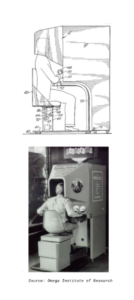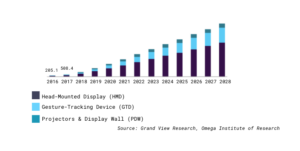- Industries
Industries
- Functions
Functions
- Insights
Insights
- Careers
Careers
- About Us
- Retail
- By Omega Team

Virtual Reality (VR) is a computer-generated simulation of three-dimensional space that a user interacts with. Applications can span from video games, education, and can even be used to host business meetings. The functional usage and development of the electronic systems around VR has grown by leaps and bounds since its first inception in 1957. Omega has developed a comprehensive timeline to share the accelerated advancement in Virtual display.
Figure 1: VR Timeline

Within the last decade, innovation of VR technology has become more and more fleshed out, improved, and increasingly practical. Due to the coronavirus pandemic, people were forced to work from home– VR technology has made the work-from-home concept more palatable. Strategically put, this article will highlight a business perspective, exploring the initial fascination, exemplifying humanity’s early attachment in the age of computers, and demonstrating the concept of work-from-home VR.
First Literary Use – Origins of Interest
The first well-credited description of what would become modern VR was a story called Pygmalion’s Spectacles written by Stanley G. Weinbaum in 1935. The story describes a professor named Ludwig who devises a pair of glasses that allowed him to experience a completely fictitious story as a character named Pygmalion. The story goes on to have Ludwig make Pygmalion be a stone smith, where he creates a stone woman named Galatea that he ultimately falls in love with.
Early Machine Example
Most people don’t think about VR as being an old technology, but the first versions of the technology date back to the late 1950s developments such as the Sensorama, pictured below:
Figure 2: Sensorama

A person sits in the Sensorama and is met with sensory simulators including touch, smell, and sound. This is considered one of the first VR devices. It created these effects through a stereoscopic color display, odor emitters, stereo sound system, and could even emit wind – all while playing a film for the user.
It is clear, even decades ago, that the world was shifting towards a VR-oriented experience and the technology would continue to prove over many decades to modern-day. What if businesses could take this technology and improve upon it, making it a viable option to work from home?
Modern Day VR – Oculus and Beyond
Thanks to grand advances in personal and enterprise computational power of computers – virtual worlds have become incredibly expansive. An iconic example is the game Skyrim (the fifth installment of The Elder Scrolls series of video games) – which covers almost 15 square miles and has incredibly high-quality graphics. In 2017, Skyrim became available in VR – marking one of the most expansive video games of all time available as a virtual world to interact with. The hardware used to interact with such a virtual world is very important. One example of a VR headset (also known as a head-mounted display, or HMD) is the Oculus.
Founded by Palmer Luckey, the Oculus series of VR HMDs was meant to be more affordable and accessible to gamers – and succeeded in his effort. One example of his success is his Kickstarter campaign for the Oculus Rift. It started at a hefty price of ~$600 but achieved almost 7,000 backers and the product took off (the product was eventually discontinued despite success). Sequential models of the Oculus HMDs almost halved in price while achieving increasingly better graphics and computational abilities. The HMD VR life is now attainable by most people who wanted them because of their affordability, and the concept now seems to be almost a household product for gamers and professionals alike. Looping back to the Coronavirus pandemic, what would happen if we could work from home, but in VR?
Facebook and Work from Home VR
As the coronavirus continues and a delta variant is shaking up the working world – Facebook has become a stalwart supporter of those that wish to work from home. In fact, Facebook has announced that it will give all of its employees the abilities to request that they want to work from home – this was decided in May 2020. They have been in talks of using their acquisition of Oculus to enhance the work from home experience via VR.
While the work is still in its early stages, the beginning phases appear promising – take a look at this example from Facebook’s Reality Lab/Oculus:
Video Notice: At Facebook Connect, we introduced Infinite Office—a collection of new capabilities designed to create a virtual office space that will feel more productive and flexible. Learn more about the Oculus for Business ISV program: https://ocul.us/2Tw2bxl
The idea – called Infinite Office – shows what it could be like to have an entire office stored inside a VR headset that would be user-friendly and easy to interact with and supply all workspace needs without ever leaving the home. Simple touch gestures are used to resize and reorient a number of screens that are familiar to most – pinch, drag, and zoom.
Spatial – AR/VR Office Meeting Spaces
It is one thing to have a virtual desktop – what about an entire virtual meeting – virtual people included! One such company revolutionizing how we work from home is Spatial – built off the Oculus and Vive (another VR company) platforms allows people to literally “meet” in (virtual) person. The benefit to this is saving money that would normally go towards plane tickets and taking precious time to travel. It offers easy ways of organizing thoughts in traditional ways that agile businesses function – such as sticky notes for iterative design. Please see the video below for the Oculus for Business example from Spatial:
Video Notice: Spatial is how work should be. Create a lifelike avatar from a selfie and turn any room into a 3D workspace, empowering teams to visualize, organize, and collaborate on ideas remotely while feeling like they’re next to each other. Whether working from home or the office, Spatial brings teams closer together. Spatial is just one of the innovative ISVs in our ecosystem helping companies accelerate success with VR solutions. Learn more about the Oculus for Business ISV program: https://ocul.us/2Tw2bxl
It is interesting to note that the hand gestures do not require a hand-held remote, giving a very “natural” feel when using it. The company stresses a humanistic approach to make the experience as “normal” as possible – similarly to how normal computers and cellphones are now designed.
Trend of the VR Market
The market cap of the VR market in 2020 was approximately $15.81 billion and is expected to have a compound growth rate of 18 percent through 2028.
Figure 3: U.S. Virtual Reality Market Size

Conclusion
VR has captured our attention for many decades, and each new decade comes with new improvements that make the VR experience more beneficial to users as well as advance how we learn, grow, and achieve. Its applications are growing each and every day.
With the Coronavirus pandemic still enforcing work-from-home measures, technology companies are supplying a plethora of options for companies to provide optimal work-from-home options. VR is starting to gain more headway in the corporate environment, and the advances of how much can be done without leaving the home is becoming more “natural” every day.
Subscribe
Select topics and stay current with our latest insights
- Functions